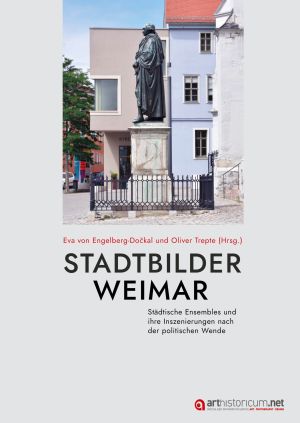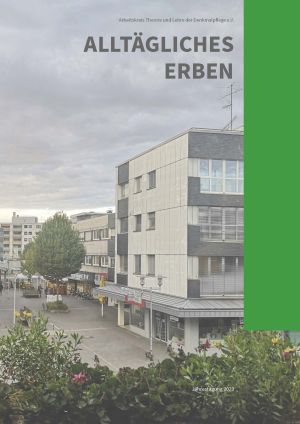Engelberg-Dočkal, Eva von
Mimetische Praktiken in der neueren Architektur: Prozesse und Formen der Ähnlichkeitserzeugung
Quotation, copy, montage, reconstruction, imitation and mimicry are typical approaches in the architect's daily routine. Until today, the paradigm of originality is still predominant and clouding the view on mimetic phenomena. In 2016, the convention "Resemblance: Processes and Forms" was held at the library of the Werner Oechslin foundation in Einsiedeln. This volume is a collection of twelve papers contributed to the convention and two additional articles by the editors. The focus was set on researching the methods of generating similarity in recent architecture and was organised by the projects encompassed by the DFG-SNF-research group "Media and Mimesis."
Stadtbilder Weimar: Städtische Ensembles und ihre Inszenierungen nach der politischen Wende
The result of a seminar held at the Bauhaus-Universität Weimar in the summer semester of 2018, this volume offers a discerning overview of architectural and urban development in Weimar after the political change. The common perception of the inner city as a still-intact historical centre is critically reflected upon. The extent of construction and its influence on present cityscapes is discussed based on the examination of several different areas. Beginning with the building activities of the 1990s, the articles discuss the creation of urban identity, especially Weimar’s role in the Model City Programme, as UNESCO World Heritage Site, and a European Cultural City in 1999. The main questions focus on dominant themes and defining identifying objects, particularly regarding modern architecture coexisting with the traditional motif of the classic city.
Alltägliches Erben
When considering historical cities, monuments and architectural heritage, a large part of the building stock is left out – marginalized as too ordinary or mundane. It often seems as if only “the highlights" make it into the art historical and preservationist canon. The conference volume ALLTÄGLICHES ERBEN therefore deals with fundamental questions about the perception, appreciation and value of “everyday architecture”. In different perspectives, international, historical, and theoretical backgrounds of the everyday are illuminated, building tasks and challenges of monument preservation are discussed.
Renationalisierung oder Sharing Heritage? Wo steht die Denkmalpflege im Euopäischen Kulturerbejahr 2018?
„Überall in Europa erleben wir gegenwärtig deutliche Renationalisierungsbewegungen und eine Inanspruchnahme des kulturellen Erbes für Identitätsbildungsprozesse von Ländern und Regionen. Im Zuge dessen werden die Grenzen zu Anderen deutlicher als zuvor markiert und Fragen der Zugehörigkeit zum Erbe kritisch ventiliert (z.B. gehört der Islam zu Deutschland/Europa? müssen wir Grenzkontrollen reaktivieren? etc.). Diesem Trend suchen europäische Institutionen durch die Betonung gemeinsamer Werte und Traditionen entgegenzusteuern – nach der Deklaration von Faro 2005 gilt das nicht zuletzt für die Ausrufung des europäischen Kulturerbejahres, das 2018 unter dem Motto Sharing Heritage steht und zu einer Neu-Betrachtung des kulturellen Erbes unter Prämissen des Kulturtransfers und der Rezeption von Ideen auffordert. Grenzräume erfahren dabei als Austauschregionen, aber auch als potentielle Konfliktregionen eine besondere Beachtung. Denkmalpflege, Archäologie und Museologie sind durch die aktuellen Neubewertungen des kulturellen Erbes wie alle anderen sammelnden Fächer zu einer Positionsbestimmung herausgefordert.“
Ingrid Scheurmann










